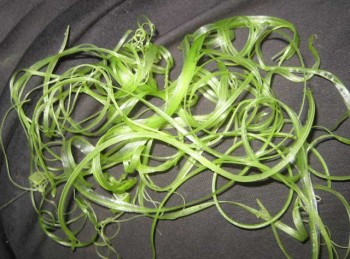
Harvesting wild edibles is not like shopping at the grocery store, where you can get your favorite fruit or vegetable the whole year long. In the wild, seasons change.
Some time ago I read a story about increased-Twitter-use coinciding with rising depression due to a person’s feelings of “missing out” on parties or social events that someone else tweeted about. Had there been no tweet, there would have been less chance of the person even realizing a party had taken place.
My sister and I talk about this feeling of “missing out” in other ways too. If a summer passes where she hasn’t made it to the beach, the water park, camping, the lake, the pool, and a half dozen other places, she feels like she and the kids have missed out.
I do it with wild edibles. “We have to get some cow parsnip before the season’s over,” I catch myself saying to Gregg, a touch of panic to my voice. For alas, the grocery store cannot fill this need for me.
Two Fails
Compounding my recent fear of no-more-wild-edibles were two consecutive fails—both involving harvesting too-old plants, a mistake I seem to repeat time and time again despite many documented realizations about the phenomenon.
First were the dandelion noodles, which we made for a second time two nights ago from dandelions past their prime, the yellow flowers already turned to seed heads but the stalks still light green, as Samuel Thayer (Nature’s Garden, 2010) says they should be if you want to make his “noodles” out of them.
Admittedly, this was something of a test on my part—I wanted to see just how old a dandelion I could get away with here in my magical high country at 11,000 feet in the Colorado Rockies where everything is wonderful and perfect. I collected a good batch of old-yet-light-green dandelion flower stalks, boiled them for 15 minutes, and served. Amidst the too-tough stringy ones, there were a few over-melted soft ones, but as you can imagine from my description, the eating process was frustrating and the overall effort was a FAIL.
We also gathered a batch of elkslip aka mountain marsh marigold (C. leptosepala), subject of my recent obsession. There were a lot of young leaves on non-flowering plants, but we also took young-looking, light green leaves on older plants, and frankly Gregg may have grabbed some old, big leaves from flowering plants because I saw a couple of flowers in his bag.
I had wanted to impress the wild-edible-eating brother of Gregg’s snowboardcross athlete, so when we went over there for dinner I brought the elkslkip and attempted to make it into dip. After 30 minutes of boiling, however, the leaves were tough and yucky-tasting and we tossed ‘em. (There is a chance that they tasted bad because instead of dropping them into boiling water, this time I had a pot of extremely hot-but-not boiling water into which I threw each leaf as I washed it, causing some of them to turn a weird gray-black color, after which I slowly brought the whole pot of leaves to a boil. Hence they may have turned out terrible due to cooking technique rather than timing of picking—I don’t know for certain as the “test” had too many variables.)
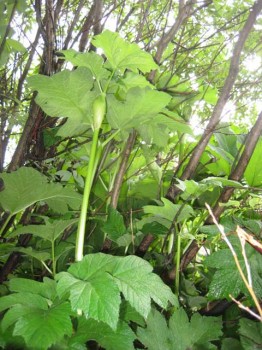
The good thing, at least, is that the brother never showed—so unless he reads my blog, which I don’t think he does, my reputation is still intact. Elkslip dip, however, was FAIL #2. And have I mentioned how much I despise letting things go to waste?
Cow Parsnip, Dock Still Going Strong
We spent a lovely weekend getting my mind off my “failures” in celebration of a recent other success—landing a summer temp job writing for the local paper. A&E apparently leads to a social life, so Gregg and I attended the Keystone Wine & Jazz festival Saturday, where we saw the Sideguys and Big Sam’s Funky Nation (whom I loved). We spent the night in Breckenridge and then on Sunday saw a local band, the GRiNZ (also wonderful), at the Dillon Amphitheatre. We skateboarded, spent time with friends, and happily watched the sporadic cloudbursts of this past weekend.
On the way home, at 6 p.m. Sunday night, we stopped for cow parsnip and dock “one last time” lest we miss the season. The plants were spectacular, covered in raindrops and bathed in bright evening sunlight.
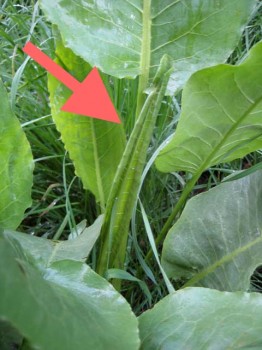
I’d seen large-leafed dock going to seed from the window on our drives, so I feared that dock season was past already—but this did not seem to be the case in our favorite patch. Some plants were going to seed, but even those had young, newly unfurling leaves on them, and many of the plants, though large, were not there yet.
We quickly harvested a good batch of young, unfurling or still rolled-up leaves, Gregg proudly displaying his selection to me.
Next up was cow parsnip. Having recently spotted the large, white umbels of flowering cow parsnip in several places from the passenger seat of the car, I had a similar worry that the season was over. We went to a spot where the now-rushing creek almost overflows the private road and climbed into the underbrush of recently cut but not cleared willow boughs. The cow parsnip we found and foraged was not flowering. There were many big leaves, to be sure, but with some bushwhacking and getting on my hands and knees in the wet underbrush I was able to spy relatively young growth from below, which I reached under and snipped with my foraging scissors (which are not really foraging scissors at all but the kitchen scissors that Gregg would like back at some point.) I almost left the larger petioles (leaf stalks), taking only the leaves, when I remembered Thayer’s (2010) bit about peeling medium-large-but-still-soft petioles and dipping in sugar, so I cut some of those along with their leaves. Later, the peeled, sugared petioles were tasty—almost a little mild, Gregg opined, but definitely yummy.
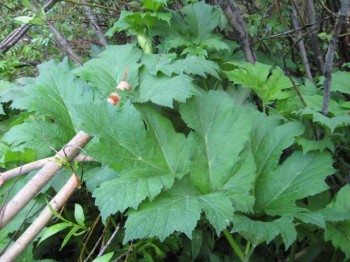
Anyway, it appears that right now is a good time of year (at 10,000 feet) to identify cow parsnip by its giant white flower umbels and leaves, which look like Queen Anne’s lace and maple leaves on steroids, respectively, not to mention its one-of-a-kind scent, then seeking a less mature, non-flowering patch from which to harvest the tasty new leaves. (Do NOT confuse cow parsnip with poisonous water hemlock, which also has big white flower umbels, but parsley or carrot-like leaves. Also take caution when harvesting cow parsnip while sweating in sunlight; it purportedly causes a nasty skin irritation, though I myself have never sweated while harvesting cow parsnip.)
Fear Relieved
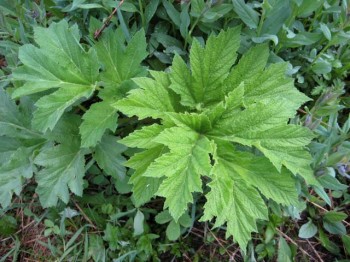
Anyway, nothing like a successful foraging trip to relieve the fear of scarcity. The rain fell, making the plants grow, washing it straight away.
Of course I haven’t eaten any of these plants yet, so that will be the ultimate test. Who knows? Lulled by the rain into a false sense of security, I could be fast on my way to FAILS #3 and #4. In either case, I’ll try to let you know soon, for I do so much love writing about dock and cow parsnip.
ATTN neophytes: I have a bunch of detailed elkslip, cow parsnip, and dock entries on this site that I can’t be bothered to link to right now. If you want/need more info on any of these plants, just type its name into the search box top right or better yet use the tag cloud. Cheers.
WARNING: Per Thayer (2010): “Cow parsnip’s juices contain furanocoumarins, which can cause blistering burns if the juice gets on your skin and is exposed to sunlight.” He also describes a related plant, giant hogweed (H. mantegazzianum), which has become invasive in areas of Ontario, the eastern US, the Pacific Northwest, and elsewhere, that is “extremely dangerous” in terms of its potential to burn the skin and eyes. Thayer thinks it “might” be edible, but readers should regardless exercise caution with H. mantegazzianum, which he describes as having “more deeply cut leaf lobes” and says “can grow to 16 feet in height.”

Nice to see someone else working with cow parsnip. What do you use the leaves for? A potherb? I like the hollow young stalks, blanched and sugared, and I will grind the seeds to use as a spice. If you like the smell of cow parsnip, you will like the ground seeds. Gives you a reason to return to your patch in a month or two…
Yes, a potherb mostly. I boil the young, newly unfurling leaves for 10 minutes and then serve with butter, soy sauce, and finely chopped raw onions per Kathryn G. and Andrew L. March’s 1979 book, Common Edible and Medicinal Plants of Colorado. I’m excited about the seeds…thanks for that; I’ll be sure to try it out!